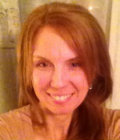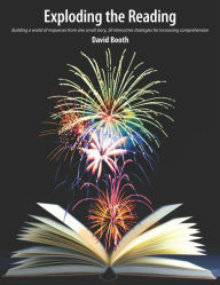Exploding the Reading to Increase Comprehension
Exploding the Reading: Building a world of responses from one small story; 50 interactive strategies for increasing comprehension
By David W. Booth
(Stenhouse/Pembroke Publishers, 2014 – Learn more)
 Reviewed by Julia K. Colombo
Reviewed by Julia K. Colombo
From the very first page of David Booth’s Exploding the Reading, I could tell this book was different. Where were the countless references to the Common Core State Standards? Why was there no mention of Response to Intervention? Why did there appear to be an emphasis on integrating the arts and literacy?
The answers to these questions are found in one easily overlooked fact—Professor David Booth is Canadian. As it turns out, our neighbors to the north have much to offer in terms of teaching literacy.
 Exploding the Reading is a fairly thin book packed with resources (50 according to the subtitle) that K-12 teachers might use to help students make meaning of what they read. The book is a product of Booth’s “Selchie Project,” a classroom-based research effort in which 40 teachers and 1000 students, ranging from kindergarten to high school, read and responded to the various iterations of one folktale about a mythical sea creature. Limiting the story allows Booth to focus on his ten specific modes, or ways, of responding to text.
Exploding the Reading is a fairly thin book packed with resources (50 according to the subtitle) that K-12 teachers might use to help students make meaning of what they read. The book is a product of Booth’s “Selchie Project,” a classroom-based research effort in which 40 teachers and 1000 students, ranging from kindergarten to high school, read and responded to the various iterations of one folktale about a mythical sea creature. Limiting the story allows Booth to focus on his ten specific modes, or ways, of responding to text.
The book itself is organized into twelve chapters:
- The Meaning-Making Power of Student Response
- Organizing a Response-Based Classroom
- Text Talk
- Telling and Retelling Stories
- Reading and Viewing Connected Texts
- Giving Voice to Words in Print
- Writing as a Response
- Responding through the Arts
- Responding through Role Play
- Research and Inquiry
- Technology and Texts
- Texts as Sources of Language Knowledge
The first two chapters offer an explanation, rationale, and implementation suggestions for a multimodal response-based classroom. The remaining chapters explore each of the response modes in depth, first explaining the mode and then offering first-hand accounts of real teachers using the mode with the students in their classrooms.
Throughout the book, Booth provides additional commentary and resources in the margins (including references to some of my personal literacy favorites: Kelly Gallagher, Lucy Calkins, Jeff Wilhelm.)
A valuable book for beginners & veterans
Exploding the Reading offers valuable literacy information for teachers at all stages of their careers. For beginning teachers or those new to teaching with literacy in mind, Booth’s book explicitly shows what effective literacy instruction looks and sounds like in an actual classroom. The author presents a balanced approach to literacy instruction in the 21st century, including a mix of whole class, small group, and individual lessons that use both traditional and contemporary technological approaches.
Every lesson includes multiple readings of a text and some form of interaction with others as a way to process ideas—reading and rereading, thinking and rethinking, discussing, and returning to the original text to harvest its meaning. Those of us living in Common Core states would recognize this as close reading, text-dependent inquiry, and collaboration.
In fact, echoes of all the Common Core literacy standards can be found throughout the book, from examining theme across multiple texts and media to analyzing the author’s purpose via character perspective, to using text evidence to support a claim.
For more seasoned literacy teachers, Exploding the Reading provides a wealth of creative ways teachers can help all readers interact with text more deeply. Specifically, Booth allows us to watch teachers seamlessly integrate the arts into almost every single lesson, not only those one would expect to find in Chapter 8, “Responding through the Arts.”
For example, in Chapter 5, “Reading and Viewing Connected Texts,” a teacher works with first and second graders to express the meaning of Una and the Sea Cloak through dance. Students use the formal elements of dance (body, energy, space, and timing) to understand the text at a deeper level and to communicate that understanding in a performance. Another lesson in that chapter has students charting and drumming the main character’s heartbeat at four targeted points in the story.
In every chapter, teachers address a variety of learning styles by incorporating tableaux, role-play, music, drawing, multi-media, sculpture, and a variety of other arts-based activities, offering all students opportunities to grapple with and comprehend texts. The arts (dance, drama, music, and visual arts) are truly integrated into instruction, not the typical make-a-diorama-after-you’ve-read-the-text type lessons. In a word—Wow.
I would definitely recommend Exploding the Reading by David Booth to teachers of all grade levels and subject areas. The book offers valuable, creative strategies for teaching all students the literacy skills they need to be critical thinkers in a global society (whether they reside in Canada, the United States, or elsewhere).
Julia Colombo is a sixth grade language arts teacher at Mattoon Middle School in Mattoon, Illinois. In addition to serving as team leader, she has sponsored an after-school student arts and writing group called The P.A.W. She has also served as the president of the East Central-EIU chapter of the Illinois Reading Council and sits on the editorial advisory board for the Illinois Reading Council Journal. She is currently serving her first year on the Mattoon Arts Council.


































